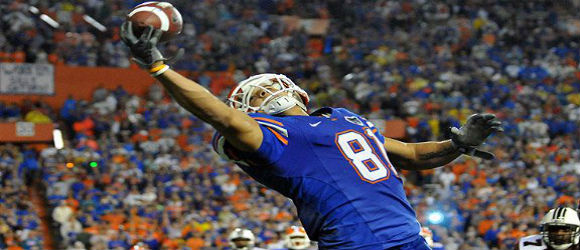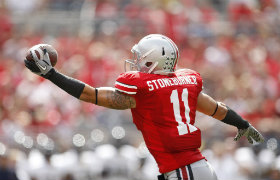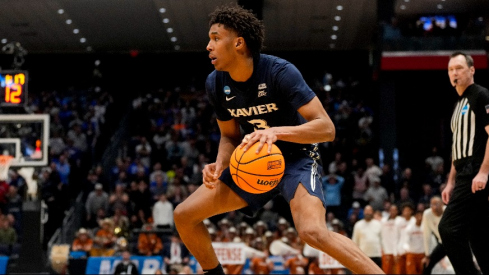
Welcome to the second part of my stat session series on Urban's previous position groups, in which I'll be examining tight ends.
Lately I've become increasingly interested in what Ross dubs "Pivot Players", or those that play hybrid positions. While reading Chris Brown's excellent new The Essential Smart Football I came across a chapter detailing how the New England Patriots managed to overcome the Jets' overload blitzes:
The presence of tight ends-where they will line up, what will they do?-dictates terms back to Rex Ryan, who would much rather cut loose and go on carrying his father's torch as the destroyer of pretty-boy quarterbacks...Unpredictability is the key. Is a play a run or a pass? Which direction is it going? How will it work? These hybrid weapons give offenses options in ways that even great players with more specific skills and roles cannot. They simplify defenses by making them uncertain.
It's clear that pivot players are not only something that Urban is fond of, but also part of a more general change in football. While "tweener" was once considered a derogatory term, the ability to play multiple positions is now a valued on both offense and defense.
I thought it might be interesting to take a deeper look at how Urban has used tight ends at his previous coaching stops - have they all been pivot players? Are they always well integrated into the passing offense? What are their physical attributes?
Finally, what does all of this mean for Stoneburner and company this year? Many people have written before about how excited Jake is for his senior year under Urban and how he'll likely flourish with the new offense. He's already emerged as one of the team's leaders and one of Urban's vaunted spring playmakers.

Once again, I used data from Florida's official roster and from sports-reference.com to assemble a dataset of Florida's tight ends from 2006-2010.
Physical data
Before I go in to some more in depth analysis, let's take care of some simple descriptive statistics and observations: First, during these five years, Urban averaged just under 5 tight ends on his roster each season. Urban's tight ends weigh an average of 244 pounds with a standard deviation of 15 pounds. The population of tight ends has an average height of 6' 4'' and a standard deviation of an inch and a half.
Physically then, we've just described the average tight ends just about anywhere. Bill Walsh, in his "How I Evaluate Each Position" chapter of Finding the Winning Edge, says his ideal size is 6'4.5'' and ~245 pounds. Clearly, Urban's tight ends are physically no different than any other teams.
However, if we look only at the players that started for Urban (also those that recorded >10 receptions on the year), we find that the average height is actually slightly lower - at just under 6'3'' - and the average weight is a bit more, at 250 pounds.
Though we're looking at a relatively small dataset here, it's enough to see that while Urban's average tight end has prototypical size, his starters are actually a bit shorter than normal. Now, it's not exactly a statistically significant difference - Aaron Hernandez, Jordan Reed, and Trey Burton were ~6'2", which is just about 1.3 standard deviations away from the mean height - but it's noteworthy nonetheless.
role in offense: receiving and pivot players
 See, Stoney has this one-handed catch thing too
See, Stoney has this one-handed catch thing tooWhat is probably more interesting is that really only a single player each year managed to really make an impact on offense. Each season, only one player was able to record more than ten receptions, and there was only one year in which two tight ends snagged over 100 yards (Aaron Hernandez's freshman year).
Furthermore, in every year except for Aaron Hernandez's junior year, the starting tight end had 380, 508, 381, and 210 receiving yards. In contrast, Jake Stoneburner has been criminally underused at Ohio State yet still managed 222 and 193 receiving yards the past three years (even with one of the worst air attacks ever last season).
It is also worth noting that Aaron Hernandez's junor year saw him explode for 850 yards on 68 receptions. Those 68 receptions are twice as many as any other tight end had during Urban's five years at UF.
Also of importance, almost every starting tight end for Urban at Florida was a pivot player - generally playing multiple positions and with multiple duties, and always a part of the passing game. This was never more true than in 2010, when the true starting tight end was Jordan Reed, with Trey Burton playing tight end along with about four other positions. Jordan Reed is officially listed on the Florida roster as a TE/QB and Trey Burton as a QB, but both combined for 289 receiving yards.
In contrast, not a single one of Urban's backup tight ends could really be considered a pivot player - not only were they all bigger, more traditional tight ends, but they were never really a part of the passing game.
We're starting to get a pretty clear picture of how Urban uses his tight ends: the starting tight end will more than likely be the fastest and biggest receiving threat, but not necessarily the biggest player. Generally tight ends are a part of the passing game, but not THAT much more than we'd expect from a coach with a well developed (or even merely competent) passing game.
Really, the "Urban loves him some tight ends" storyline is built largely on Hernandez's junior campaign. I think this more generally reflects the fact that Urban doesn't really care what position you are - he'll even create a new hybrid position for you if he has to - if you're an exceptional talent, then he will get you the ball.
The prognosis for Jake is good for next year, but it's unclear how much love the backups Heuerman and Vannett will get next year. In 2013, however, look for the most dynamic receiving threat to get the start.
No wonder that Jake Stoneburner said that Urban's prior experience with Hernandez made him happy: "It's something I've been waiting for since I graduated high school, being able to go out there knowing you're going to get the opportunity to get the ball more than once or twice a game."

